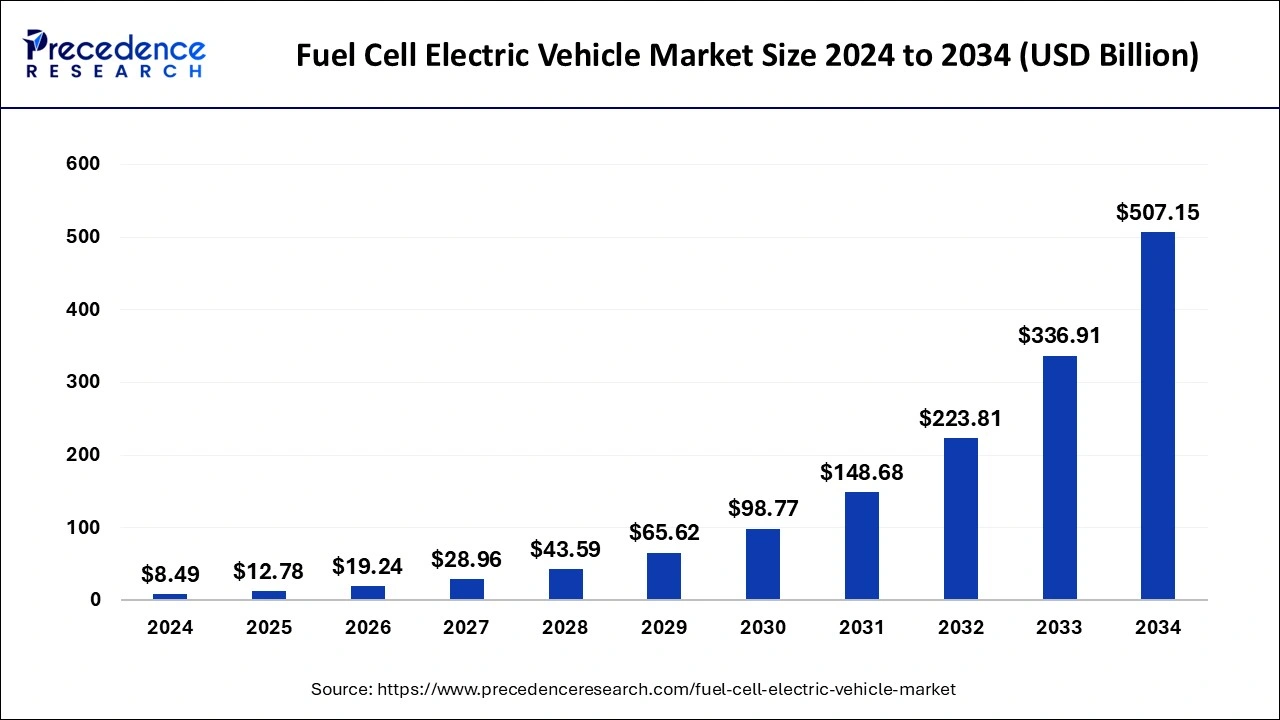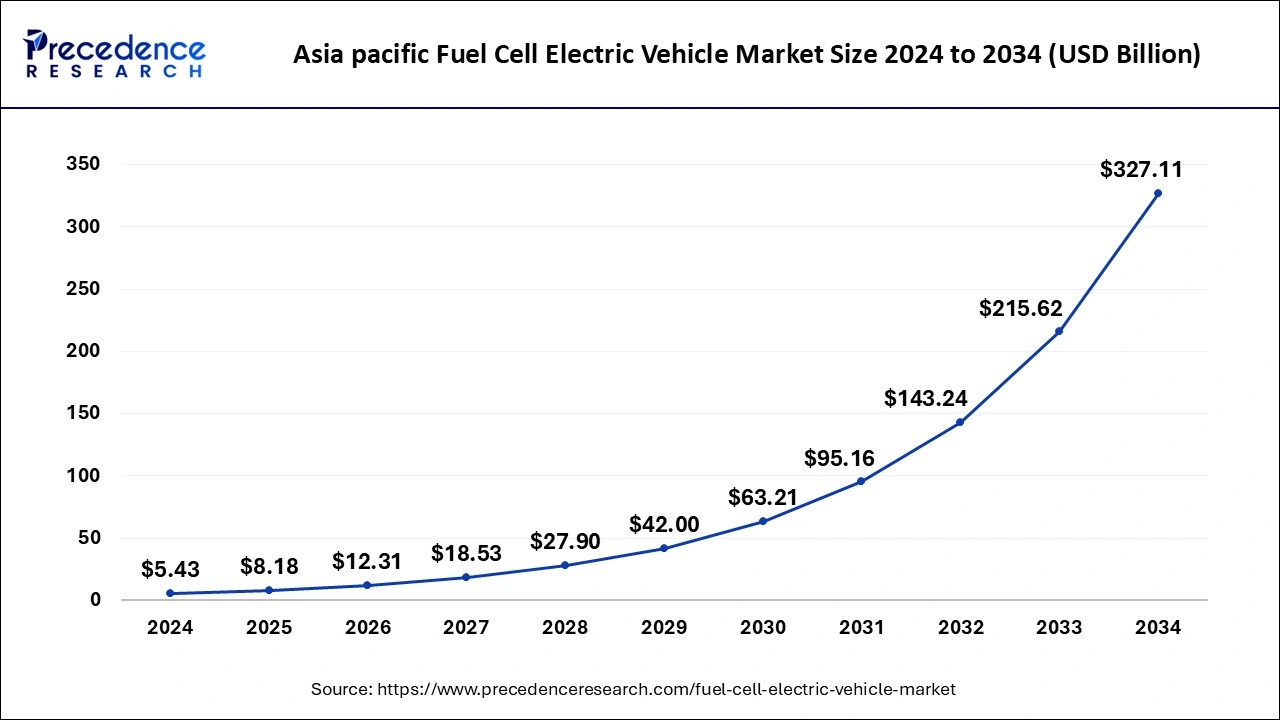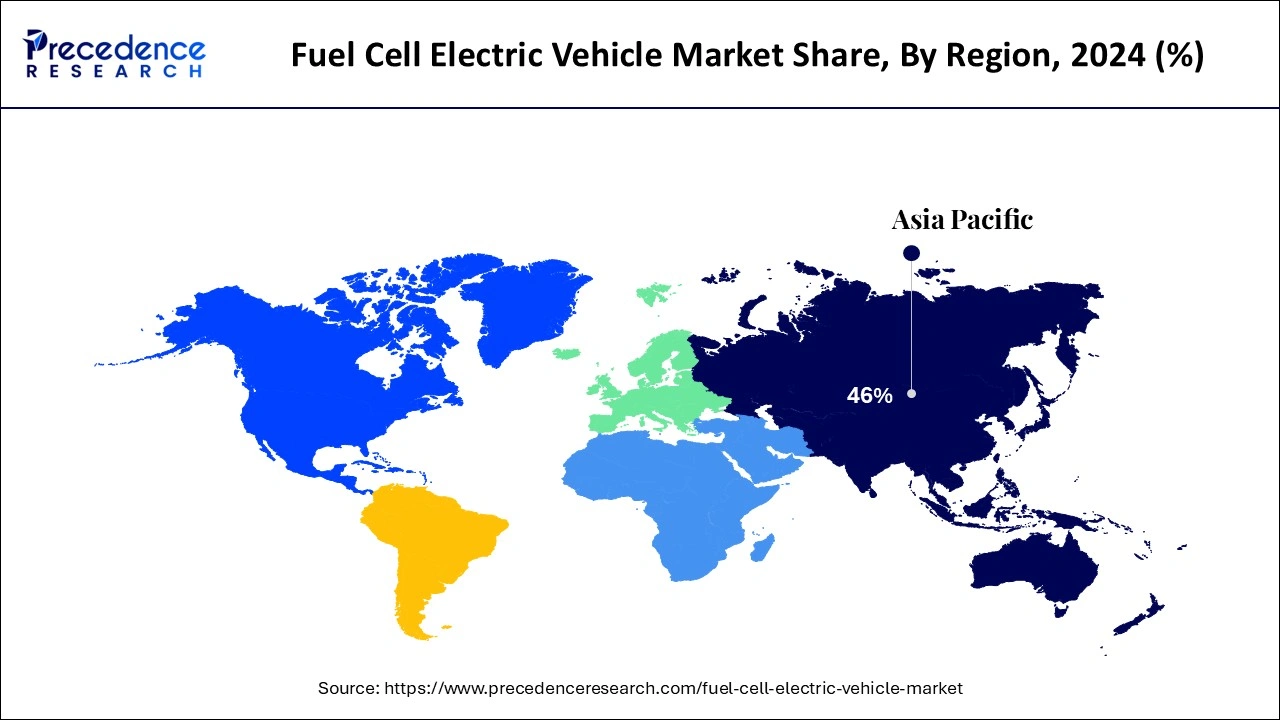What is the Fuel Cell Electric Vehicle Market Size?
The global fuel cell electric vehicle market size is calculated at USD 12.78 billion in 2025 and is predicted to increase from USD 19.24 billion in 2026 to approximately USD 639.30 billion by 2035, expanding at a CAGR of 47.88% from 2026 to 2035.The rising demand for electric vehicles due to growing concern for environmental issues has raised the fuel cell electric vehicle market demand.

Fuel Cell Electric Vehicle Market Key Takeaways
- Asia Pacific dominated the global market with the largest market share of 64% in 2025.
- North America is projected to expand at the notable CAGR during the forecast period.
- By vehicle, the passenger vehicle segment has held the largest market share in 2025.
- By range, the short distance segment captured the biggest market share in 2025.
What is Meant by Fuel Cell Electric Vehicle Market?
The fuel cell technology is not yet capable of delivering very high our needs associated with different circumstances. In a declaration by Japan, it's stated of being carbon neutral by the year 2050. As an awareness related to the benefits of good air quality and the bad effects of regular emissions is driving the market. Governments are taking initiatives to invest and enhance the infrastructure for the electric vehicles. Further helps in expanding the market. Various technological advancements and increased number of refueling facilities are helping the market grow. Rapid industrialization and expansion of the production facilities is fostering the acceptance of fuel cell electric vehicles in Asia Pacific region. A major challenge ahead of the FCEV market is high investment required for the electric vehicle charging infrastructure.
However, there are increasing investments from the government as well as the private sector. In the development of this infrastructure, so the market is expected to grow. The FCEV market was badly impacted by the COVID-19 pandemic. Due to lockdowns and restrictions on traveling the production and delivery was delayed. The raw material supplies were also delayed. However, post pandemic, there has been a recovery as there is an ease on restrictions and there are supportive government policies. The FCEV use a fuel cell to convert or transform the chemical energy in oxygen and hydrogen directly into the electrical energy. The hydrogen is supplied from an onboard storage tank, while the oxygen is derived from the air. If economical FCEV's are developed they will reduce the dependency on oil and help in combating global warming.
Role of AI Integration in Fuel Cell Electric Vehicle Market
The integration of AI in the fuel cell electric vehicle market contributes to the advancement of the market. The implementation of AI has influenced the manufacturing of electric vehicles as it can detect defective parts and enhance the reliability of the market. It can help to predict the maintenance of the vehicle which reduces the extra charges for sudden damage of the vehicle. It can monitor the charging of the cell and alert for prior charging which is helpful for the consumers. It helps to enhance the performance of the vehicle, decrease charges, and help the integration of enhanced features.
Fuel Cell Electric Vehicle Market Outlook
- Industry Growth Overview: The fuel cell Electric vehicle market is undergoing strong growth, projected to increase from billions to tens of billions by 2030, boosted by government mandates for decarbonization, growing environmental knowledge, and crucial investments in hydrogen infrastructure, with Asia-Pacific contributing and Europe showing a huge presence, though difficulties remain in building a complete ecosystem.
- Major Investors: It includes global auto giants such as Toyota, Honda, GM, Hyundai, Daimler (Mercedes-Benz), and BMW, alongside customized fuel cell tech firms such as Ballard Power, Bloom Energy, Plug Power, and FuelCell Energy, plus major industrial players such as Cummins, Linde, and Air Products.
- Startup Ecosystem: The market is a rapidly innovating sector targeted on overcoming key challenges such as infrastructure gaps, expense, and design limitations, mainly for heavy-duty and commercial vehicles. These agile startups are introducing advanced hydrogen storage, modular systems, and new ownership models.
What are the Growth Factors in the Fuel Cell Electric Vehicle Market?
- As a result of strict vehicle emission regulations in many nations across the world the fuel cell electric vehicle market shall boom.
- In North America, stringent rules are made for the emission regulations, which make North America the greatest market.
- In European countries, governments are investing in the development of fuel-cell electric vehicle technologies because driving the global market.
- In the Asia Pacific region, the adoption of electric vehicles is leading to growth in this market. The FCEV's market provides low-emission mobility solutions. Latin America is also adopting this technology.
- Owing to the benefits like improved efficiency, zero emission and lower refuelling time, the segment is expected to grow in the forecast period.
- Rapid industrialization and extensive production facilities, which are made available, are helping in penetrating the market. As the private sector and the government sectors are investing in building the infrastructure, growth is expected.
Market Scope
| Report Coverage | Details |
| Market Size in 2025 | USD 12.78 Billion |
| Market Size in 2026 | USD 19.24 Billion |
| Market Size by 2035 | USD 639.30 Billion |
| Market Growth Rate from 2026 to 2035 | CAGR of 47.88% |
| Largest Market | Asia Pacific |
| Base Year | 2025 |
| Forecast Period | 2026 to 2035 |
| Segments Covered | Vehicle, Type, Range, Geography |
| Regions Covered | North America, Europe, Asia-Pacific, Latin America and Middle East & Africa |
Segment Insights
Vehicle Insights
The vehicle segment can be further classified in two bus, truck, passenger vehicles and light commercial vehicles. As there are stringent norms to eradicate the vehicle pollution the category of the passenger vehicle is expected to have a larger market share. As there is a rising per capita income the passenger vehicles are expected to have a larger market share. Consumers are demanding for clean personal mobility. Countries are planning to convert the taxis and cabs into fuel cell electric vehicles for eradicating the pollution. By the year 2040, South Korea is targeting to deploy around 1,20,000 fuel cell vehicles.
Range Insights
The range segment covers short range distances and long range distance is covered by the fuel cell electrical vehicles. The short distance segment is expected to reach 45% growth from 2026 to 2035. In comparison to the long range category, the short range category will witness a faster growth as there is a rising demand for low emission vehicles for commuting everyday. The consumers are giving a preference to FCEV's In order to cover shorter distances for traveling or commuting. In order to transport goods within ports and airports, many companies are making use of FCEV's. Many transport vehicles are used for covering short range distances to eliminate their carbon footprints.
Regional Insights
The Asia Pacific fuel cell electric vehicle market size is exhibited at USD 8.18 billion in 2025 and is projected to be worth around USD 412.53 billion by 2035, growing at a CAGR of 48% from 2026 to 2035.

The fuel cell electric vehicles in the Asia Pacific region is expected to have a good market size. In order to curb pollution levels and the ban on diesel engines that is stringent government policies in place. In order to accept these vehicles the Asia Pacific region is making policies. Across the country the construction of 1000 refueling stations will be done by 2032 in order to meet the industry demand with the stringent regulation policies in place.

The Asia Pacific market for the fuel cell electrical vehicle will rise globally. In the Asia Pacific region, the major players you Hyundai Motor Company and Toyota Motor Company are offering cars, buses and logistical vehicles. Asia Pacific FCEV market size is projected to hit around USD 15 billion by 2032.
China Fuel Cell Electric Vehicle Market Analysis
China's market is growing steadily, boosted by strong government fund, strategic investment, and aim on commercial vehicles, with projections showing remarkable ownership increases by 2030-2035, though difficulties remain in expense, supply chain maturity, and even infrastructure, with policy support vital for achieving deep decarbonization goals in transport.
North America is poised to lead the market as rising investment in the entire hydrogen value chain, from manufacturing to refuelling stations, creates a supportive ecosystem. Strong federal and even state initiatives, supporting for hydrogen infrastructure (production, storage, distribution), and also regulations such as California's Advanced Clean Fleet (ACF) rule incentivize zero-emission commercial vehicles.
U.S. Fuel Cell Electric Vehicle Market Trends
The U.S. fuel cell electric vehicle market is rising, driven by strong government support, remarkable investment in hydrogen infrastructure, and even increasing need for heavy-duty, zero-emission transport, mainly for long-haul trucking and buses, with major players such as Toyota and Hyundai leading passenger FCEVs meanwhile expanding into commercial applications.
Value Chain Analysis of Fuel Cell Electric Vehicle Market
- Distribution to Dealers and OEMs
The supply chain and logistics are included in moving FCEVs and even their components from manufacturers to numerous sales channels. This includes different, sometimes hybrid, strategies to reach the final user and other businesses, in contrast to the conventional internal combustion engine (ICE) market. - Retail Sales and Financing
Retail sales as well as financing for fuel cell electric vehicles largely mirror those of conventional vehicles but face unique difficulties due to high upfront expands, limited hydrogen infrastructure, and even low market penetration. The process depends heavily reliant on government incentives along with innovative financing models to mitigate perceived risks by lenders.
Fuel Cell Electric Vehicle Market Companies
- Audi AG: Audi AG remarkably impacts the Fuel Cell Electric Vehicle market via its role as the Volkswagen Group's central hub thus, for fuel cell development, collaborating with partners such as Hyundai to share tech, investing deeply heavily in FCEV R&D, and targeting on integrating fuel cell tech into future premium providing as part of its wider electrification strategy towards carbon neutrality, targeting for both battery-electric and even fuel cell solutions.
- Ballard Power systems Inc.: Ballard Power Systems offers PEM fuel cell technology (stacks & modules) for heavy-duty vehicles such as buses, trucks (transit, long-haul, mining), trains, and even marine vessels, allowing zero-emission transport with long range and also quick refueling, partnering with producers like Ford Trucks, Solaris, and Quantron to integrate these systems for decarbonization.
Other major Key players
- BMW Group
- Daimler AG
- Honda Motor Co limited
- Volvo group
- Toyota Motor Corporation
- General Motors company
- Man Se
- American Honda Motor Co.
- Toshiba
Recent Development
- In September 2024, BMW announced the launch of its first-ever series production hydrogen-powered fuel cell electric vehicle (FCEV) in 2028.
- In October 2024, Hyundai announced the launch of INITIUM hydrogen fuel cell electric vehicle (FCEV) concept at its �Clearly Committed' event held at Hyundai Motorstudio Goyang.
Segments Covered in the Report
By Vehicle
By Range
By Geography
For inquiries regarding discounts, bulk purchases, or customization requests, please contact us at sales@precedenceresearch.com
Frequently Asked Questions
Ask For Sample
No cookie-cutter, only authentic analysis – take the 1st step to become a Precedence Research client




 sales@precedenceresearch.com
sales@precedenceresearch.com
 +1 804-441-9344
+1 804-441-9344